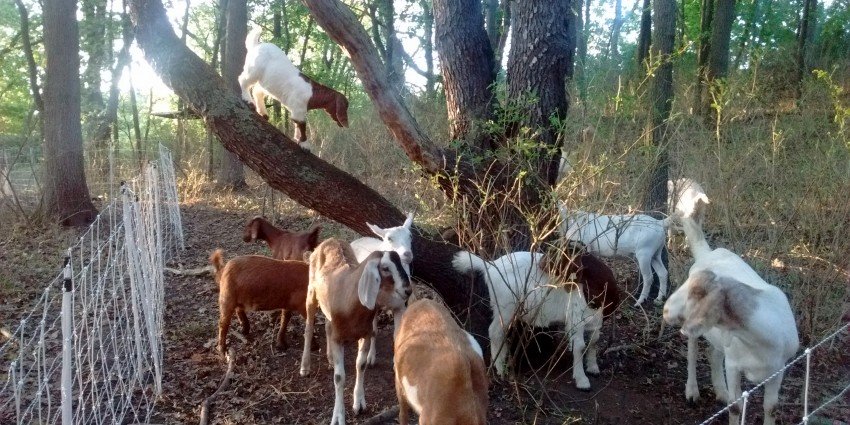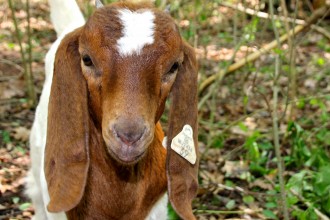KALAMAZOO, Mich.—An even larger contingent of temporary landscape services workers will be on the Western Michigan University campus this summer to clear an overgrown woodlot.

The first of this year's two eating crews. (Photo credit: Nick Gooch)
Already on-site is the 10-goat crew hired last summer as part of a successful one-week pilot project to test the animals' viability as an environmentally friendly land management tool. The goats are rented out as four-footed "lawn mowers" to homeowners, farmers, commercial property owners and other clients by Garrett and Gina Fickle from Munchers on Hooves in Coldwater.
The original crew is back for a second helping of weeds and invasive species after chewing its way through nearly one-half acre of the unwanted vegetation last year. They will be formally reintroduced to the campus and local community from 9 to 10 a.m. Friday, June 2, at the Sindecuse Health Center in Parking Lot 51 off of Gilkenson Avenue.
On hand for the event will be Garrett Fickle and Nick Gooch, WMU horticulturist and the landscape services staff member who originally proposed the goat pilot project. For directions to WMU or a campus map, visit wmich.edu/maps/printables.php.
New kid on the block

The youngest member of the goat work crew. (Photo credit: Jeanne Baron)
The 2016 pilot project whetted WMU's appetite for employing more goats this summer. In addition to last year's crew, another 10 goats have been hired. The two crews will eat their way through an expected 15 acres by the time they leave campus about a week before fall classes start.
Providing a little extra help will be a new addition to the temporary summer workers, a 7-week-old girl who's mom, Mucha (pronounced MOO-cha) was part of last year's work crew. The Fickles are allowing WMU to name the youngster, and landscape services will report the moniker when one is decided.
The goats are being contained and protected by a portable electric fence installed around one-quarter acre south of Goldsworth Valley Pond in the large woodlot between the pond and Sindecuse Health Center. Once the goats clear this initial section, they will be moved to new quarter-acre plots further west throughout the summer.
Why they're baAAck
The goat pilot project was an unqualified success, Gooch reports, noting that the animals are a less costly and more natural and efficient way of clearing large areas of problematic overgrowth compared to using large machines, chemicals and, depending on the terrain, people.
"We found that the goats were very effective at clearing the thick low-growth and toxic plants like poison ivy," he says. "That type of vegetation restricts view and the ability of our landscape services staff to navigate the woodlots for management purposes."
Gooch also notes that WMU has redesigned the Goldsworth Valley Pond area and has been working to make it a more inviting, yet natural, green space. The goats are helping by keeping some of the nearby woodlot's invasive vegetation from encroaching.
"The overall goal of bringing in the goats is improving woodlot health and trying to reduce the spread and future growth of invasive and opportunistic species that are common from the frequent disturbances that we see as a result of ongoing campus construction," Gooch says. "Also, increasing visibility throughout the woodlot adds a safety component and enhances aesthetics, which complement the adjacent pond area."
For more information about goats at WMU, contact Nicholas Gooch at nicholas.j.gooch@wmich.edu or (269) 387-8557. Information about Munchers on Hooves is available by visiting munchersonhooves.weebly.com or contacting the Fickles at munchersonhooves@yahoo.com or (517) 403-2138.
For more WMU news, arts and events, visit wmich.edu/news.
Related article
Goats to be tested on WMU campus as woodlot management tool | July 7, 2016
